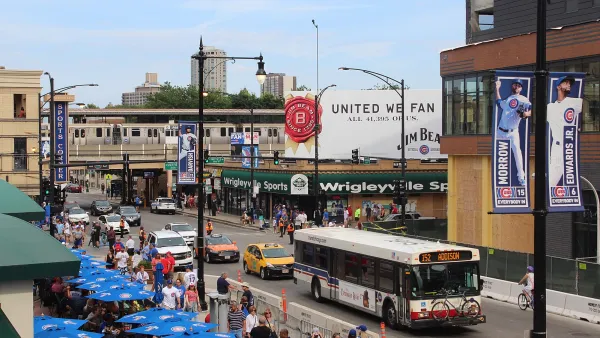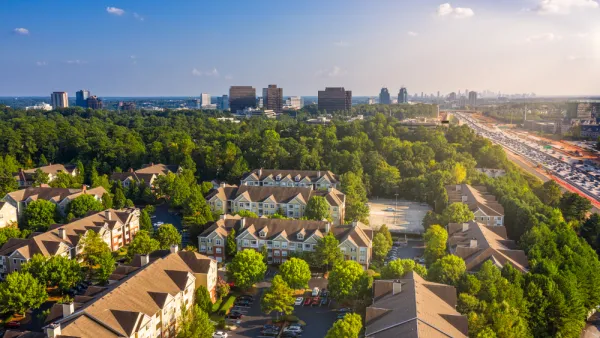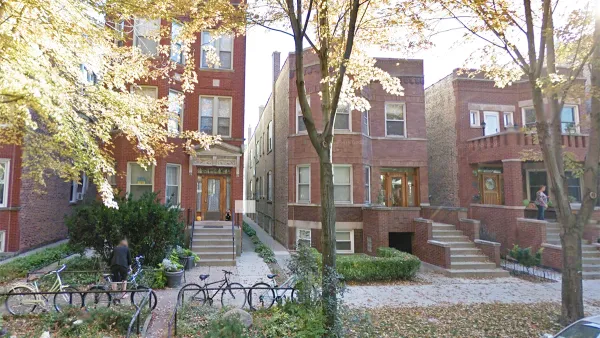A few days ago, I was in a Chicago neighborhood called Lincoln Square, on Lincoln Avenue just south of Lawrence Avenue. Lincoln Avenue looks like many posh urban neighborhoods- narrow, walkable streets inhabited by gelato-eating, prosperous-looking people. Even on a weeknight, the shops and streets of Lincoln Square betrayed no evidence of a recession.*
A few days ago, I was in a Chicago neighborhood called Lincoln Square, on Lincoln Avenue just south of Lawrence Avenue. Lincoln Avenue looks like many posh urban neighborhoods- narrow, walkable streets inhabited by gelato-eating, prosperous-looking people. Even on a weeknight, the shops and streets of Lincoln Square betrayed no evidence of a recession.*
Lincoln intersects with Lawrence Avenue just a block from the core of Lincoln Square. Lawrence Avenue resembles a suburb more than it resembles Lincoln Square; it is six lanes wide (though unlike in most suburbs, two of them are used for parking), and some shops are behind parking lots. But Lawrence's retail is far less prosperous than that of Lincoln; a good number of Lawrence's storefronts seemed to be vacant, and others were occupied by dollar stores and other non-carriage trade businesses.**
Both Lincoln Avenue and Lawrence Avenue have the same housing stock and thus the same neighbors, the same city government (and thus the same tax rates and school districts) and the same distance from downtown (about seven miles). Thus, these two intersecting streets constitute the perfect controlled experiment on the popularity of walkable urbanism. If people basically liked shopping on car-oriented speedways, Lawrence would have fewer vacant storefronts than Lincoln. Yet the opposite is true. It follows that where everything else is equal, shoppers prefer walkable urbanism to car-oriented suburbanism.
At this point, readers may be asking themselves: why, then, do some suburbs continue to prosper? Because not everything else is equal: an unwalkable suburb may be further away from troubled neighborhoods (usually leading to more prestigous schools and less crime), in a less poverty-packed jurisdiction (thus leading to lower taxes), or have a newer housing stock. Thus, not every suburb will look as scruffy as Lincoln Square.
But the tale of these two adjacent streets nevertheless tells us something: that city life with walkability is appealing to American consumers, while city life with less walkability is anything but.
*For a few pictures of Lincoln Square, see
http://atlantaphotos.fotopic.net/p66205703.html
http://atlantaphotos.fotopic.net/p66205709.html
http://atlantaphotos.fotopic.net/p66205702.html
**Although I took no pictures of Lawrence, you can see the street by going to the 2200-2600 blocks of West Lawrence Avenue on Google Street View.

National Parks Layoffs Will Cause Communities to Lose Billions
Thousands of essential park workers were laid off this week, just before the busy spring break season.

Retro-silient?: America’s First “Eco-burb,” The Woodlands Turns 50
A master-planned community north of Houston offers lessons on green infrastructure and resilient design, but falls short of its founder’s lofty affordability and walkability goals.

Delivering for America Plan Will Downgrade Mail Service in at Least 49.5 Percent of Zip Codes
Republican and Democrat lawmakers criticize the plan for its disproportionate negative impact on rural communities.

Test News Post 1
This is a summary

Test News Headline 46
Test for the image on the front page.

Balancing Bombs and Butterflies: How the National Guard Protects a Rare Species
The National Guard at Fort Indiantown Gap uses GIS technology and land management strategies to balance military training with conservation efforts, ensuring the survival of the rare eastern regal fritillary butterfly.
Urban Design for Planners 1: Software Tools
This six-course series explores essential urban design concepts using open source software and equips planners with the tools they need to participate fully in the urban design process.
Planning for Universal Design
Learn the tools for implementing Universal Design in planning regulations.
EMC Planning Group, Inc.
Planetizen
Planetizen
Mpact (formerly Rail~Volution)
Great Falls Development Authority, Inc.
HUDs Office of Policy Development and Research
NYU Wagner Graduate School of Public Service






























